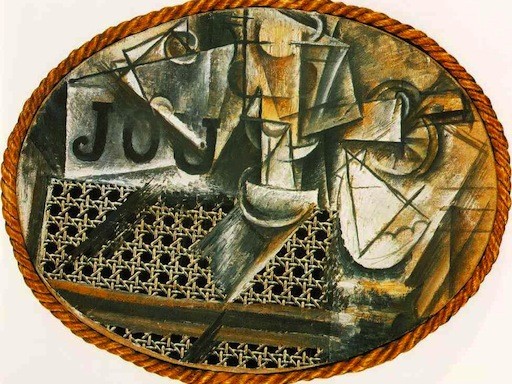"Collage is the twentieth century's greatest innovation." — Robert Motherwell
"After Picasso and Georges Braque, collage became the most consequential visual-art form of the twentieth century." — Peter Schjeldahl
While artists have been layering images and incorporating autonomous elements into their work since the advent of paper, collage truly emerged as a medium in its own right in the early years of the 20th century with the Cubist experiments of Pablo Picasso and Georges Braque. The duo coined the term “collage” (from the French verb “coller,” meaning “to glue” or “to stick”) to describe works composed from pasted pieces of colored paper, newsprint, and fabric, considered at the time to be an audacious intermingling of high and low culture. It revolutionized modern art.
Whereas the artists’ earlier Cubist phase, known as “Analytic Cubism,” was comprised of paintings that fragmented the world into a series of basic lines and curves, this later period of “Synthetic Cubism” involved combining fragments of various materials to create a new whole. In Picasso’s iconic Still Life With Chair Caning (1912), perhaps the most famous work of this period, the artist playfully renders a tabletop still life by incorporating everyday elements like newspaper and rope, as well as a trompe-l’oeil piece of mass-produced oilcloth printed with a chair-caning pattern.
Inspired by Cubist experiments, artists associated with Dada—particularly the movement’s Berlin branch—began incorporating collage techniques into their work. Hannah Hoch, Richard Huelsenbeck, John Heartfield, and others pioneered the technique of photomontage, using preexisting photographs, often drawn from mass-media sources, to create composite images that sharply critiqued German society and culture in the aftermath of World War I.
Drawing on the foundations of Dada, neo-avant-garde artists of the 1950s like Robert Rauschenberg and Jasper Johns created assemblages that brought collage techniques into three dimensions—laying the groundwork for much contemporary sculpture—as well as works on paper that incorporated found elements drawn from the mass media and everyday life. Likewise, the incorporation of materials and images culled from mass culture and consumer goods was a signature of Pop art, exemplified by collage-based works like British artist Richard Hamilton’s Just What Is It That Makes Today’s Homes So Different, So Appealing? (1956), which ironically parodied the lifestyles peddled in advertising through the direct inclusion of its imagery.
Contemporary artists continue to use the medium of collage in new and innovative ways, experimenting both formally and conceptually. Artists like Lorna Simpson and Nina Yuen have used collage techniques as a means of addressing topics like race, class, and politics, while the collective assume vivid astro focus merges the archaic and the futuristic, culling imagery from the Internet and analog sources alike.
A Cut-Down History of Collage
























